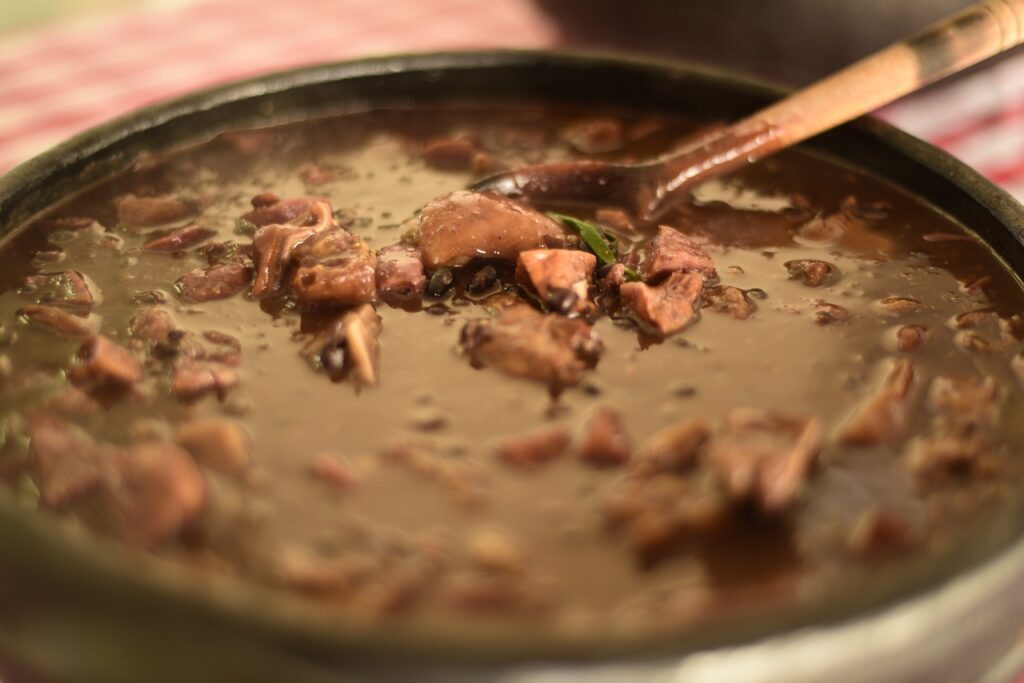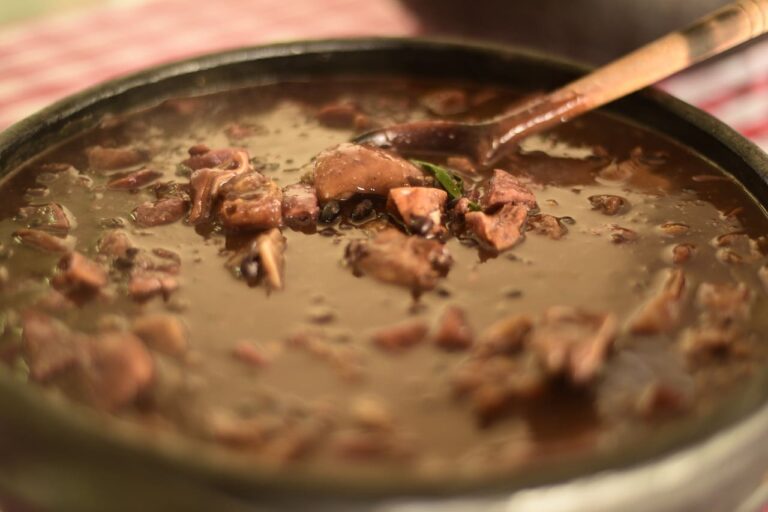
If you’re a food enthusiast who’s keen to delve into Brazilian cuisine, you can’t overlook feijoada. Often referred to as the national dish of Brazil, feijoada is a black bean stew that embodies the rich history of this South American country.
In this guide, we’ll explore its history, common ingredients, a classic feijoada recipe, and the cultural significance of this Brazilian black bean stew.
History of Feijoada
The roots of feijoada trace back to both African and Portuguese culinary traditions. It’s commonly thought that the dish was initially made by enslaved Africans who combined black beans (“feijão” in Portuguese) with leftover meat scraps.
Over time, the recipe evolved and absorbed influences from Portuguese and other European cuisines, much like cassoulet in French cooking or the various pork stews in Italian and Spanish kitchens.
The modern version you’ll find in Brazil today is a far cry from its humble origins and is considered a luxurious meal that often brings family and friends together.
Common Ingredients in Feijoada
The backbone of feijoada lies in its hearty mix of black beans and various cuts of meat. Common meat choices include pork shoulder, pork ribs, chorizo, and linguica (a Portuguese smoked sausage).
It’s important to use soaked beans for a richer flavor and quicker cook time. To add layers of flavor, the use of spices like black pepper, bay leaves, and cloves of garlic is essential.
The dish is traditionally served with white rice, collard greens, and farofa, a crispy side dish made from cassava flour (also known as manioc flour).
A Classic Feijoada Recipe
Ingredients:
- 1 lb dried black beans, soaked overnight
- 1 lb pork shoulder, diced
- 1 lb pork ribs
- 1/2 lb chorizo
- 1/2 lb linguica
- 1 large onion, chopped
- 4 cloves garlic, minced
- 2 bay leaves
- Salt and black pepper to taste
- Olive oil
- Optional: orange slices for garnish
Steps:
- Prep Time: 20 minutes
- Cook Time: 2-3 hours
- Total Time: 2 hours 20 minutes to 3 hours 20 minutes
- In a large bowl, drain the soaked beans and set them aside.
- In a large pot or slow cooker, sauté onions and garlic in olive oil over medium-high heat.
- Add the diced pork shoulder, pork ribs, chorizo, and linguica to the pot. Cook until browned.
- Add the drained and soaked beans, bay leaves, salt, and black pepper.
- Add enough water to cover the ingredients.
- Cook on low heat for 2-3 hours, or until the beans are tender and the meats are fully cooked.
Nutrition:
- Calories: 600 kcal
- Saturated Fat: 15g
- Cholesterol: 100mg
- Carbohydrates: 50g
- Protein: 40g
- Vitamin C: 50% DV
- Calcium: 15% DV
- Potassium: 20% DV
Note: Feijoada is even better when made a day in advance, as the flavors will have a chance to meld together. Reheat gently before serving.
Learn More about Brazilian Cuisine
Feijoada is just the tip of the iceberg when it comes to Brazilian recipes. Foods like kielbasa, a type of smoked sausage, and corned beef also make an appearance in Brazilian kitchens.
From Rio to the Amazon, the cuisine varies but always represents a rich blend of indigenous, African, and European influences.
Cultural Significance of Feijoada
The dish holds a special place in Brazilian culture,.
Besides being a delicious meal, feijoada carries a historical narrative, sharing a tale of resilience and creativity that dates back to times of hardship. It serves as a reminder of how far Brazilian cuisine has come, evolving from a sustenance meal to a dish that delights both the palate and the soul.
Variations of Feijoada: Regional and Modern Twists
Feijoada has undergone many transformations over the years, with different regions and chefs putting their own unique spin on the dish. In some parts of Brazil, for example, feijoada is made with seafood, while in others, it is prepared with chicken or goat.
In recent years, there has also been a trend towards modernizing feijoada, with chefs experimenting with new ingredients and techniques to create innovative and exciting new dishes.
Despite these variations, feijoada remains an enduring symbol of Brazil’s rich culinary traditions and cultural heritage.
Visit the homepage, download our app, or check out our Help Center to get started.
